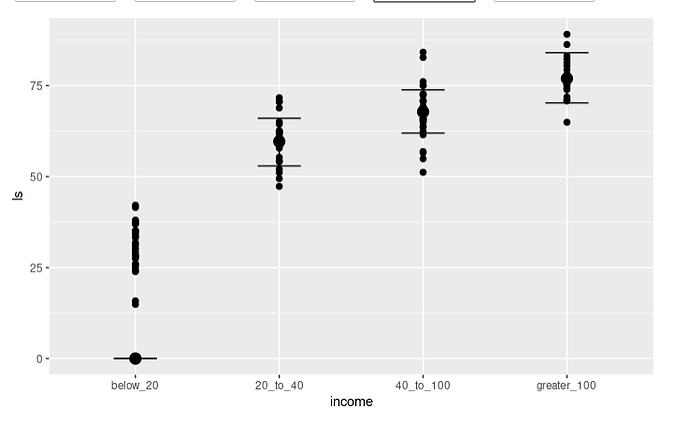Thank you for the kind advice and apologies for the broad framing of my question.
After reading some more I think I have narrowed in on what confuses me in this context.
I ran some simulations using the same example given in the monotonic vignette and got the following results.
A) In a no intercept vs. with intercept model the first monotonic simplex parameter gets overestimated. Why is that? Is there a way to look at the design matrix used to fit the model? I saw the post and documentation about 0+ meaning not mean centering the predictors in the design matrix, but I don’t have a good intuition about what that means in the context of the monotonic function. In general I thought the 0+ syntax avoids computing the parameters with regards to a reference level of the categorical factor, but rather computes them with reference to the grand mean and the main problem in doing so is potential overparameterization. But now these simulations show different effect sizes for 1 of the parameters. I would have either expected the CI intervals to get bigger or the error estimate go up, but that does not seem to be the case.
income_options <- c("below_20", "20_to_40", "40_to_100", "greater_100")
income <- factor(sample(income_options, 100, TRUE),
levels = income_options, ordered = TRUE)
mean_ls <- c(30, 60, 70, 75)
ls <- mean_ls[income] + rnorm(100, sd = 7)
dat <- data.frame(income, ls)
fit1 <- brm(ls ~1 + mo(income), data = dat, seed = 123)
Formula: ls ~ 1 + mo(income)
Data: dat (Number of observations: 100)
Draws: 4 chains, each with iter = 2000; warmup = 1000; thin = 1;
total post-warmup draws = 4000
Regression Coefficients:
Estimate Est.Error l-95% CI u-95% CI Rhat Bulk_ESS Tail_ESS
Intercept 30.94 1.33 28.22 33.55 1.00 2862 2693
moincome 15.40 0.66 14.12 16.73 1.00 2757 2266
Monotonic Simplex Parameters:
Estimate Est.Error l-95% CI u-95% CI Rhat Bulk_ESS Tail_ESS
moincome1[1] 0.63 0.04 0.56 0.71 1.00 3058 2049
moincome1[2] 0.17 0.04 0.08 0.25 1.00 3026 2253
moincome1[3] 0.20 0.04 0.12 0.28 1.00 3608 2327
Further Distributional Parameters:
Estimate Est.Error l-95% CI u-95% CI Rhat Bulk_ESS Tail_ESS
sigma 6.86 0.50 5.95 7.91 1.00 3696 2570
fit2 <- brm(ls ~ 0 + mo(income), data = dat, seed = 123)
Formula: ls ~ 0 + mo(income)
Data: dat (Number of observations: 100)
Draws: 4 chains, each with iter = 2000; warmup = 1000; thin = 1;
total post-warmup draws = 4000
Regression Coefficients:
Estimate Est.Error l-95% CI u-95% CI Rhat Bulk_ESS Tail_ESS
moincome 25.66 1.17 23.42 28.01 1.00 2393 2559
Monotonic Simplex Parameters:
Estimate Est.Error l-95% CI u-95% CI Rhat Bulk_ESS Tail_ESS
moincome1[1] 0.78 0.06 0.67 0.89 1.00 2354 1963
moincome1[2] 0.11 0.05 0.01 0.22 1.00 3311 2100
moincome1[3] 0.12 0.05 0.02 0.22 1.00 2614 1995
Further Distributional Parameters:
Estimate Est.Error l-95% CI u-95% CI Rhat Bulk_ESS Tail_ESS
sigma 17.64 1.26 15.43 20.38 1.00 2545 2114
B) I also noted that the effect disappears when using the 0+ syntax in a non-linear model with an added categorical predictor. I don’t really understand how that makes a difference.
(Just the monotonic predictor in NL-syntax: larger effect is still there)
dat$x <- sample(c("a", "b", "c"), 100, TRUE)
fit7 <- brm(
formula = bf(ls ~ 0 + inc,
inc ~ 0 + mo(income),
nl=TRUE),
data = dat,
seed = 123)
Formula: ls ~ inc
inc ~ 0 + mo(income)
Data: dat (Number of observations: 100)
Draws: 4 chains, each with iter = 2000; warmup = 1000; thin = 1;
total post-warmup draws = 4000
Regression Coefficients:
Estimate Est.Error l-95% CI u-95% CI Rhat Bulk_ESS Tail_ESS
inc_moincome 25.66 1.17 23.42 28.01 1.00 2393 2559
Monotonic Simplex Parameters:
Estimate Est.Error l-95% CI u-95% CI Rhat Bulk_ESS Tail_ESS
inc_moincome1[1] 0.78 0.06 0.67 0.89 1.00 2354 1963
inc_moincome1[2] 0.11 0.05 0.01 0.22 1.00 3311 2100
inc_moincome1[3] 0.12 0.05 0.02 0.22 1.00 2614 1995
Further Distributional Parameters:
Estimate Est.Error l-95% CI u-95% CI Rhat Bulk_ESS Tail_ESS
sigma 17.64 1.26 15.43 20.38 1.00 2545 2114
(monotonic predictor + categorical factor: Same results for monotonic predictor as with Intercept, despite specifying 0+ on both)
dat$x <- sample(c("a", "b", "c"), 100, TRUE)
fit6 <- brm(
formula = bf(ls ~ 0 + inc + xvar,
inc ~ 0 + mo(income),
xvar ~ 0 + x,
nl=TRUE),
data = dat,
seed = 123)
Formula: ls ~ 0 + inc + xvar
inc ~ 0 + mo(income)
xvar ~ 0 + x
Data: dat (Number of observations: 100)
Draws: 4 chains, each with iter = 2000; warmup = 1000; thin = 1;
total post-warmup draws = 4000
Regression Coefficients:
Estimate Est.Error l-95% CI u-95% CI Rhat Bulk_ESS Tail_ESS
xvar_xa 29.44 1.58 26.37 32.52 1.00 2445 2512
xvar_xb 31.82 1.79 28.27 35.33 1.00 2339 2529
xvar_xc 32.02 1.66 28.74 35.25 1.00 2436 2726
inc_moincome 15.21 0.69 13.85 16.56 1.00 2064 2375
Monotonic Simplex Parameters:
Estimate Est.Error l-95% CI u-95% CI Rhat Bulk_ESS Tail_ESS
inc_moincome1[1] 0.63 0.04 0.56 0.71 1.00 2788 2603
inc_moincome1[2] 0.17 0.04 0.08 0.25 1.00 2885 2230
inc_moincome1[3] 0.20 0.04 0.12 0.28 1.00 3278 2419
Further Distributional Parameters:
Estimate Est.Error l-95% CI u-95% CI Rhat Bulk_ESS Tail_ESS
sigma 6.84 0.51 5.92 7.94 1.00 3208 2614
Sorry if these questions are still too basic for this forum, but I am also still new to statistical modeling as a whole. I would also take pointers to a more appropriate forum if they are out of place here.







